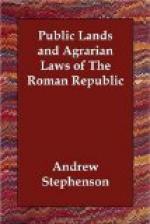[Footnote 1: Dionysius, VIII, 68; “[Greek: Oi de para touton taen upateian paralabontaes poplios Ouerginios kai Sporios Kassios, to triton tote apodeichtheis upotos, k. t. l.]”]
[Footnote 2: Dionysius, VIII, 69; Livy, II, 41, seq.]
[Footnote 3: Dionysius, VIII, 81.]
[Footnote 4: Dionysius, VIII, 69; Mommsen, I, 363.]
[Footnote 5: Niebuhr, II, 166.]
[Footnote 6: Livy, II, 41; “Tum primum lex agraria promulgata est nunquam deinde usque ad hanc memoriam sine maximus motibus rerum agitata.”]
[Footnote 7: Livy, II, 41; Dionysius, VIII, 69.]
[Footnote 8: Niebuhr, II.]
[Footnote 9: Dionysius, VIII, 81: [Greek: “Ekklaesiai te sunegeis hypo ton tote daemarchon eginonto kai apaitaeseis taes hyposcheseos.” See also VIII, 87, line 25 et seq.].]
SEC. 6.—AGRARIAN MOVEMENTS BETWEEN 486 AND 367.
Modern historians who have written upon the Roman Republic have, so far as I know, passed immediately from the consideration of the Lex Cassia to the law of Licinius Stolo. Meanwhile more than a century had passed away. Cassius died in 485, Licinius Stolo proposed his law in 376. During this century which had beheld the organization of the republic and the growth, by tardy processes, of the great plebeian body many agrarian laws were proposed and numerous divisions of the public land took place. Both Dionysius and Livy mention them. The poor success of the proposition of Cassius and the evil consequences to himself in no way checked the zeal of the tribunes. Propositions of agrarian laws followed one another with wonderful rapidity. Livy enumerates these propositions, but almost wholly without detail and without comments upon their tendencies or points of difference from one another or from the law of Cassius. As this law failed of its object by being disregarded, we may safely conclude that the most of these propositions were but a reproduction of the law of Cassius.




